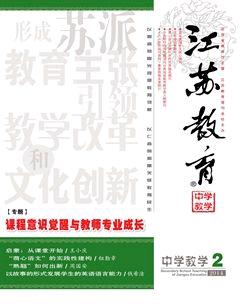以故事的形式发展学生的英语语言能力
钱希洁



【摘 要】本文主要针对当前初中英语故事教学缺乏故事味的现状,结合教学案例,从故事教学的几个主要环节阐述对初中英语故事教学的思考,从而使学生在更为浓郁的故事味中不断提升英语语言能力。
【关键词】故事 内容 语言 能力
阅读教学是初中英语课堂教学的重要课型之一,通过阅读教学丰富学生的英语语言知识、发展学生的英语阅读能力、拓宽学生的文化视野、提升学生的英语阅读素养是中学英语阅读教学的重要任务。就当前的初中英语教材而言,大多数阅读文本都具有一定的故事性,如今,一些根据经典名著改编的童话故事也逐渐走进教材,并成为学生的英语阅读文本。故事以其鲜活的人物形象、生动的故事情节、地道的英语语言和隐含的人生哲理受到了广大学生的喜爱,然而,在课堂教学中,当这些故事被抹上过于浓重的教学味的时候,它们在学生眼中就失去了原有的魅力。因此,在故事教学中,我们还需要弱化教学的痕迹,凸显故事的滋味,引导学生在故事中发展英语语言能力。本文主要以译林出版社《英语》七年级下册Unit 6 Reading板块中根据经典童话故事《爱丽丝漫游记》改写的故事Down the rabbit hole为例,结合这个故事教学两个课时教学活动中的几个主要环节阐述对故事教学的初步思考,旨在和同行探讨如何使学生在浓郁的故事味中发展英语语言能力。
一、在对故事话题的交流中,了解故事背景
文本故事Down the rabbit hole是根据英国童话大师Lewis Carroll笔下的著名童话故事Alice in Wonderland中的一个片段改编而成,对于这个童话故事,有一部分学生在他们的童年时代已经看过或听过中文版故事《爱丽丝漫游记》,因此,当学生接触这个故事文本时,他们对故事中的主人公Alice应该还会有一些印象。基于学生对这个故事的点滴印象开展交流,激起学生对这个童话故事的点滴记忆,从而在学生对这个故事回忆的基础上呈现故事的背景,进而引导他们带着对这个故事内容似曾相识的感觉走进这个英文版的故事,教学片段如下。
T:Have you ever heard the story?
(大部分学生举手表示看过这个故事的中文版本。)
S1:Yes, I have read the story , but in Chinese.
S2:I read the story in Chinese when I was in Primary School, but I have almost forgotten everything about the story.
T:Who jumped down the rabbit hole? Anybody knows?
S3:Alice jumped down the rabbit hole.
T: How do you know?
S4:My mother told me the story in Chinese when I was very young.
T: Thats good. Then anybody knows what the story is from?
S5:It is from a book Alice in wonderland.
T: How can you say it in English?
S6:I found it in our textbook.
T: Thats very good. Yes, we can find the name of the book at Page 70. Lets read it together:Alice in wonderland.
T:Do you know who wrote the story?
教师呈现关于作者的基本情况,如下:
T:Now we all know Alice fell down the rabbit hole. What else do you want to know about the story?
S7:How did they jump down the rabbit hole?
S8:What did they do after they fell down the rabbit hole?
T: OK,Then lets go into the English story together and try to get the answers about the questions.
对故事话题的交流唤醒了学生对美好童年的记忆,也唤醒了学生对这个故事相关的点滴记忆,虽然他们对这个故事的记忆已经很少,但是他们对自己童年的美好记忆和对故事内容的模糊使他们对这个英语童话故事产生了浓厚的兴趣,带着找回童年时代故事的好奇,学生自然跟着老师走进了这个童话故事。
二、在对故事的整体感知中,理解故事内容
为了让学生高质量地开展故事阅读活动,在整体上理解故事内容,理清故事发展的脉络,并在对故事整体内容的感知中初步理解故事涵盖的新的语言知识,教师创设问题情境如下:
1.Where was Alice that day?
2.What did she see?
3.What did she do then?
4.What happened later?
带着问题,学生开始尝试自己阅读这个故事,并根据以上问题找出了如下的答案:
1.Sat by a river.
2.Saw a rabbit.
3.Jumped down the rabbit hole.
4.In the rabbit hole.
通过整体阅读故事,学生初步了解了故事的全过程,即Alice是如何掉入这个兔子洞的,对故事文本内容整体上的理解为学生进一步理解文本细节内容并从中突破相关的英语语言知识提供了一个完整的语境,促使学生根据故事中事态的发展对新的语言知识所涵盖的语言意义进行判断,并做出正确的理解。
三、在对故事的深层解读中,突破语言知识
一个新的故事总是包含着一些新的语言知识,从表面上看,这些新的语言知识是学生深层次理解故事的障碍,但正是基于对这些新的语言知识的突破,学生才能更深入细致地理解故事的情节,并在深层次理解故事细节的过程中积累更为丰富的英语语言知识。因此,根据故事内容突破这些新的语言知识是故事教学的一大任务,这也是近几年英语阅读教学研究的一个重点和热点问题。对此,不同的教师采用了不同的方法,有的教师把故事中涵盖新的语言知识的句子从故事文本中挖出来,用分析、讲解和练习的方式让学生理解这些语言知识,困扰大家的是:本来比较有趣的故事教学就会因为过度的讲解和训练失去了故事的滋味;有的教师丢弃了原本有趣的故事文本,另外创设一个文本,将故事文本涵盖的新的语言知识放到这个新的文本中,加以理解和突破,虽然这种做法对学生理解相关语言知识有促进作用,然而对教材故事文本的忽略,使学生对教材故事文本的细节理解处于一个半生不熟的阶段,教材故事这个最有效的语境也没有得到充分的利用。在江苏省2013年举行的初中英语优质课展评活动中,来自南京市的王雯老师的方法很值得借鉴和推广,她将教材故事文本本身作为学生学习突破这些语言知识的大语境,引导学生在对故事的深层解读中,理解并突破文本故事所涵盖的新的英语语言知识。教学片段如下。
1.根据故事第一阶段,教师运用PPT呈现故事插图,见图(1),并创设问题情境如下:When Alice sat by the river,What did she see?
S1:She saw a rabbit.
T: Yes, she saw a rabbit passing by.(板书语言点pass by,并朗读。)
T: How did she feel when she saw the rabbit?
S2:She felt amazed.
S3:She felt surprised.
T:Why?
S4:Because the rabbit was wearing a coat and a tie.
T: Anything else do you think is very strange?
S5:The rabbit can talk.
T: What did he say? Can you find the sentence in the story?
S5:“Oh dear! Ill be late.”
T:Can you act as Alice and the white rabbit in pairs?
教师引导学生模仿故事中兔子的形象表演故事片段。
T:Anything else is very strange?
S6:And he had a watch.
教师引导学生通过对故事插图(2)的仔细观察,用英语对这个穿着西服、系着领结、戴着手表的小白兔进行描述。
T:Look at the picture,he is taking the watch out of his pocket. (板书呈现语言点take...out of...,并朗读。)
2.根据故事第二阶段,教师运用PPT呈现故事插图,见图(3),并创设问题情境如下。
T: What did Alice do?
S1:She stood up and ran across the field after the rabbit. (板书呈现语言点ran across the field,并朗读。)
T: Then what did the rabbit do?
S2:He jumped down a hole. (板书呈现语言点jumped down,并朗读。)
T: What did Alice do ?
S3:She jumped down the hole too.
T: Would you like to jump down a hole after a rabbit?
S4:No.
T: Its dangerous.
3.根据故事第三阶段,教师运用PPT呈现故事插图,见图(4),并创设问题情境如下。
T: What was the hole like?
S1:It was deep.
T: How do you know?
S1:It took long time.
T: Yes. It took Alice long time to hit the ground. Can you read the sentence?
教师呈现课文重点句:Down, down, down. Then Alice hit the ground. She found herself alone in a long, low hall. (板书呈现语言点found herself alone,并朗读。)
T:Can you try to practice this?
教师引导学生根据故事中Alice掉进兔子洞的语言描述,引导学生运用慢动作表现Alice掉进兔子洞的过程,课堂充满了孩子们尚存的童真。
4.根据故事第四阶段,教师运用PPT呈现故事插图,见图(5)(6),并创设问题情境如下。
T: Where was she then?
S1:In a long, low hall.
T: What did she do then?
S2:She looked around and saw many doors all around.
T: Can she open them?
S3:No, they were all locked.
T: What did she find at last?
S4:She found a small door and a key.
T: Did the key work?
S5:Yes. She opened the door.
T: Could she go out?
S6:No, she couldnt go through. The door is too small.
在对故事文本的深层解读中,学生对故事中Alice如何从看到一只奇怪的兔子到跟随兔子跳进了兔子洞的过程有了更为详细的了解,故事所涵盖的新的语言知识在故事的深层解读中也得到了突破。
四、在对故事的多元品读中,深化内涵理解
通过对故事的深层解读,学生对故事细节内容有了深入的了解,对故事中涵盖的新的语言知识也达到了充分的理解。但是,基于理解后的操练活动是学生将所学语言知识提升成为语言技能的重要途径。在这个基础上,引导学生通过对故事的多元品读等语言操练活动,将所学语言转化成为语言技能则是水到渠成,主要分以下几个环节:
1.引导学生有感情地整体朗读故事。
2.引导学生小组讨论故事主人公Alice的人物特征,从而让学生在巩固语言知识的同时,进一步加深对故事主人公形象的深层次理解,片段如下。
T:What do you think of Alice?Try to say sth. about Alice. You may find some sentences to support you.
S1:I think she was very brave.
T: Why?
S: Because she jumped down the rabbit hole after the rabbit.
S2:I think she liked life very much.
T: Why do you think so?
S3:In the story, she sat by a river and read books. It was very romantic, I think.
T:So I think she liked going out and enjoying outdoor life, right?
S3:I think she was very lucky.(学生大笑。)
T:Why do you think so?
S3:Because she could meet this kind of rabbit. But I couldnt. (学生又大笑。)
S4:I also think she was very brave.
T: Whats your reason?
S4:When she found herself alone in the hole, she wasnt worry at all, and tried to find the way to get out.
T:Yes, so when we meet some difficulties, try not to give up easily.
3.教师采用教材P72上Simon与Sandy的一段对话,引导学生以对话的形式谈论故事,从而进一步巩固故事内容,内容如下。
Simon:Whats the story about?
Sandy:Its about a girl. Her name is Alice. One day, she sat by a with her sister. Then she saw a white .
Simon:What did the rabbit do?
Sandy:The rabbit took a watch out of its and looked at the time.
Simon:What happened next?
Sandy:The rabbit ran across a .Alice ran after it. Then the rabbit and Alice both jumped into a hole.
Simon:What happened after that?
Sandy: Alice hit the .Then she found herself alone in a long, low . She saw a on a table and used it to open a door.
Simon:Did she go through the ?
Sandy:No, she didnt. It was too small.
4.引导学生借助黑板上的关键词,采用小组合作的方式复述故事或表演故事片段,从而进一步巩固故事内容和英语语言知识。
五、在对故事的拓展活动中,发展语言能力
英语课堂教学的最终目标是发展学生的英语语言运用能力,通过故事文本所获得的相关语言知识和语言技能只有实际运用才能逐步转化成为学生运用语言的能力。因此,在学习教材文本的故事的基础上,要创设新的语境,引导学生开展适时、适度的语言拓展活动。对此,很多教师在教学中充分展示了他们的教学智慧,在2013年江苏省初中英语优质课展评活动中,南京市选手王雯老师通过引入一个新的故事,引导学生运用教材文本故事中所学的语言知识进行表达,内容如下(划线部分为填空内容)。
Up the tree house
One sunny day,Lauren sat by a tree in a park. Then she heard a sound. She looked up and saw a dog with some flowers passing by.“Oh dear! Mothers Day is coming!”said the dog.
How amazing!Lauren stood up and ran across the park after the dog. The dog jumped up the big tree.Lauren did not want to let the dog get away,so she jumped up the big tree too.
Up,up,up,Lauren climbed for a long time,and then she reached a tree house. She found herself alone in a large,low room. There were books all around,but they were all very heavy. Lauren saw a note by one of the books but she couldnt read the words.
Then Lauren opened that book. She found a map!She tried to find the way back,but it was the map of the rabbit hole.
然后,引导学生将思维回归到自身的生活经历,通过回顾和思考,引导学生运用所学语言知识来讲述自己的故事,从而使故事教学活动从文本回归到学生的生活,在学生运用语言知识讲述自己故事的过程中体现出语言学习的价值。
在英语课堂教学中,听故事永远是受学生欢迎的。因此,为了学生对故事的这份喜欢,作为教师,我们就不妨在故事教学中尽量保持那一份令学生喜欢的故事味吧。■
(作者单位:江苏省无锡市锡山教师进修学校)

